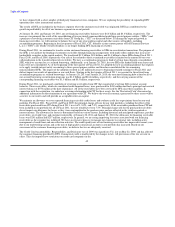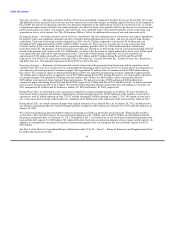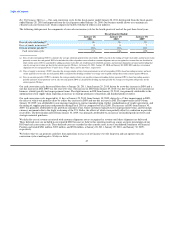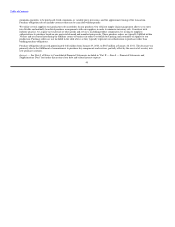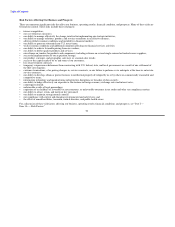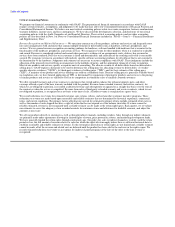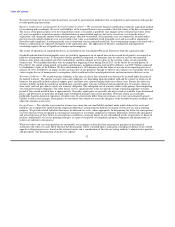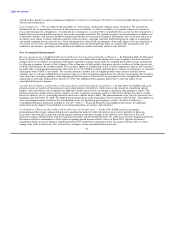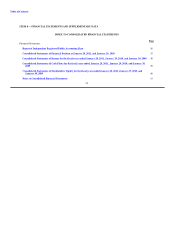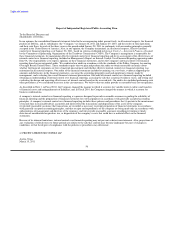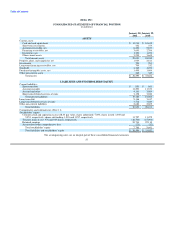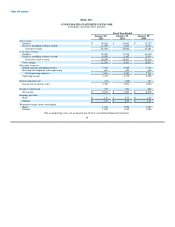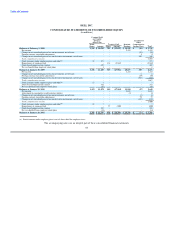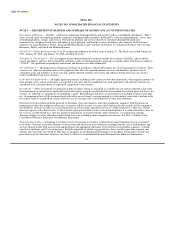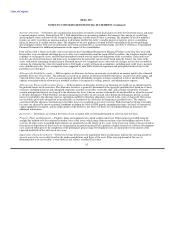Dell 2010 Annual Report Download - page 56
Download and view the complete annual report
Please find page 56 of the 2010 Dell annual report below. You can navigate through the pages in the report by either clicking on the pages listed below, or by using the keyword search tool below to find specific information within the annual report.
Table of Contents
We report revenue net of any revenue-based taxes assessed by governmental authorities that are imposed on and concurrent with specific
revenue-producing transactions.
Business Combinations and Intangible Assets Including Goodwill — We account for business combinations using the acquisition method
of accounting and accordingly, the assets and liabilities of the acquired business are recorded at their fair values at the date of acquisition.
The excess of the purchase price over the estimated fair values is recorded as goodwill. Any changes in the estimated fair values of the
net assets recorded for acquisitions prior to the finalization of more detailed analysis, but not to exceed one year from the date of
acquisition, will change the amount of the purchase prices allocable to goodwill. All acquisition costs are expensed as incurred and in-
process research and development costs are recorded at fair value as an indefinite-lived intangible asset and assessed for impairment
thereafter until completion, at which point the asset is amortized over its expected useful life. Any restructuring charges associated with a
business combination are expensed subsequent to the acquisition date. The application of business combination and impairment
accounting requires the use of significant estimates and assumptions.
The results of operations of acquired businesses are included in our Consolidated Financial Statements from the acquisition date.
Goodwill and indefinite-lived intangible assets are tested for impairment on an annual basis in the second fiscal quarter, or sooner if an
indicator of impairment occurs. To determine whether goodwill is impaired, we determine the fair values of each of our reportable
business units using a discounted cash flow methodology and then compare the fair values to the carrying values of each reportable
business unit. We concluded that there were no impairment triggering events during Fiscal 2011. At the end of the second quarter of
Fiscal 2011, the annual testing period, our market capitalization, including common stock held by affiliates, was $25.7 billion compared
to stockholders' equity of $6.2 billion. We have determined that a 10% decrease in the fair value of any one of our reporting units as of
January 28, 2011 would have no impact on the carrying value of our goodwill. Though we believe our estimates are reasonable, these fair
values require the use of management's assumptions, which would not reflect unanticipated events and circumstances that may occur.
Warranty Liabilities — We record warranty liabilities at the time of sale for the estimated costs that may be incurred under the terms of
the limited warranty. The specific warranty terms and conditions vary depending upon the product sold and the country in which we do
business, but generally include technical support, parts, and labor over a period ranging from one to three years. Factors that affect our
warranty liability include the number of installed units currently under warranty, historical and anticipated rates of warranty claims on
those units, and cost per claim to satisfy our warranty obligation. The anticipated rate of warranty claims is the primary factor impacting
our estimated warranty obligation. The other factors are less significant due to the fact that the average remaining aggregate warranty
period of the covered installed base is approximately 15 months, repair parts are generally already in stock or available at pre-determined
prices, and labor rates are generally arranged at pre-established amounts with service providers. Warranty claims are reasonably
predictable based on historical experience of failure rates. If actual results differ from our estimates, we revise our estimated warranty
liability to reflect such changes. Each quarter, we reevaluate our estimates to assess the adequacy of the recorded warranty liabilities and
adjust the amounts as necessary.
Income Taxes — We calculate a provision for income taxes using the asset and liability method, under which deferred tax assets and
liabilities are recognized by identifying the temporary differences arising from the different treatment of items for tax and accounting
purposes. We provide related valuation allowances for deferred tax assets, where appropriate. In determining the future tax consequences
of events that have been recognized in our financial statements or tax returns, judgment is required. Differences between the anticipated
and actual outcomes of these future tax consequences could have a material impact on our consolidated results of operations or financial
position. Additionally, we use tax planning strategies as a part of our global tax compliance program. Judgments and interpretation of
statutes are inherent in this process.
While we believe our tax return positions are sustainable, we recognize tax benefits from uncertain tax positions in the financial
statements only when it is more likely than not that the positions will be sustained upon examination, including resolution of any related
appeals or litigation processes, based on the technical merits and a consideration of the relevant taxing authority's administrative practices
and precedents. The determination of income tax expense
52


